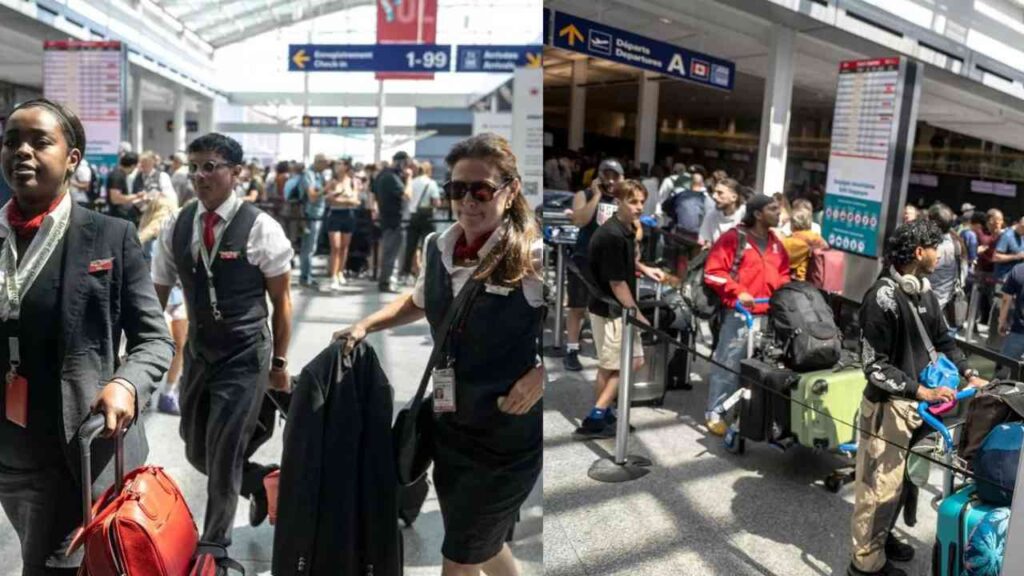Air Canada has been forced to cancel all 700 of its daily flights after more than 10,000 flight attendants walked out on strike early Saturday morning, leaving approximately 130,000 travelers stranded worldwide during peak summer travel season.
Strike Begins After Failed Negotiations
The work stoppage commenced at 1:00 AM local time on Saturday following the breakdown of contract negotiations that had been ongoing for eight months. The Canadian Union of Public Employees (CUPE), representing the flight attendants, rejected Air Canada’s request to enter government-directed arbitration, which would have eliminated their right to strike and placed the contract decision in the hands of a third-party mediator.
As flight attendants walked off the job, Air Canada simultaneously began locking them out of airports, effectively shutting down all operations for Canada’s largest airline.

International Impact
The strike’s effects have been felt far beyond Canadian borders. All Air Canada flights from London’s Heathrow Airport were cancelled, disrupting travel plans for UK passengers. The timing couldn’t be worse, occurring during the peak summer vacation period when alternative flights are scarce and expensive.
Passengers Face Difficult Choices
The human cost of the labor dispute is evident in stories like that of Montreal resident Alex Laroche, 21, and his girlfriend. The couple had been saving since Christmas for their European vacation, investing £4,200 ($8,000) in a trip to Nice, France, including non-refundable accommodations.
“At this point, it’s just a waiting game,” Laroche said, describing his dilemma of whether to book alternative flights that cost more than double their original £1,600 ($3,000) tickets and are nearly sold out.
Initially frustrated with the union’s decision to strike, Laroche said his perspective shifted after learning about the issues at stake: “Their wage is barely liveable.”
Government Intervention Attempts
Federal Jobs Minister Patty Hajdu met with both parties on Friday evening, expressing frustration with the lack of progress. “It is unacceptable that such little progress has been made,” Hajdu stated. “Canadians are counting on both parties to put forward their best efforts.”
Despite the government’s urging, negotiations have stalled, with the union claiming that Air Canada has not responded to their last two contract proposals since Tuesday.
Core Issues in Dispute
The central disagreements revolve around compensation and working conditions. Air Canada’s most recent offer included what the airline described as a 38% increase in total compensation over four years, including benefits and pensions, which they claimed “would have made our flight attendants the best compensated in Canada.”
However, CUPE rejected this proposal, arguing that the 8% first-year wage increase was insufficient given current inflation rates. The union also highlighted concerns about unpaid work that flight attendants perform when aircraft are not in the air.
Recovery Timeline and Passenger Options
Air Canada Chief Operating Officer Mark Nasr warned that even after a tentative agreement is reached, it could take up to a week to fully restore normal operations. The complexity of airline scheduling means that the disruption’s effects will likely persist well beyond the strike’s end.
The airline has committed to providing full refunds to affected passengers through its website and mobile app. Air Canada also promised to offer alternative travel arrangements through other Canadian and international carriers when possible, though it cautioned that immediate rebooking cannot be guaranteed due to high demand during the summer travel peak.
Union’s Position
CUPE spokesman emphasized the union’s willingness to continue negotiations despite the work stoppage. “We’re here to bargain a deal, not to go on strike,” he stated in an email, while criticizing Air Canada for not countering recent union proposals.
The union’s position reflects broader concerns about working conditions and fair compensation in the airline industry, particularly as travel demand has rebounded post-pandemic while worker pay has struggled to keep pace with inflation.
Broader Implications
This strike represents one of the most significant labor disruptions in Canadian aviation in recent years. With 130,000 passengers potentially affected each day the strike continues, the economic and personal costs are mounting rapidly.
The standoff also highlights the ongoing tension between airlines seeking to control costs in a competitive industry and workers demanding fair compensation for their essential roles in air travel safety and service.
As negotiations continue, thousands of travelers remain in limbo, their vacation plans and business trips hanging in the balance while two sides work to resolve their differences at the bargaining table.






